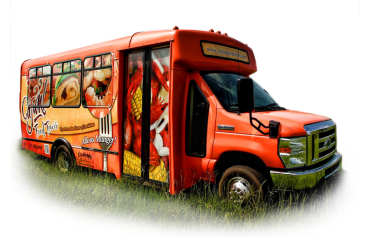Seasonal Seafood Gumbo: Why Shrimp, Crab, and Oysters Shine in the Cooler Months

When the air turns crisp and the Gulf breeze carries that hint of fall, Louisianans know it’s gumbo season. The cooler months aren’t just about comfort food – they’re about the freshest, sweetest seafood the coast has to offer. For a true Cajun feast, nothing compares to a seasonal seafood gumbo brimming with shrimp, crab, and oysters.
At Cajun Food Tours, we celebrate the flavors and traditions that make Louisiana food unforgettable. Here’s why this iconic trio shines brightest when temperatures drop and why your next bowl of gumbo should be a winter ritual.
-
Gumbo and the Rhythm of the Seasons
In Cajun country, food follows the rhythm of nature. While gumbo can be enjoyed any time of year, the ingredients tell us when it’s best.
During the cooler months – roughly September through April – the Gulf’s bounty hits its peak. Water temperatures drop, salinity levels change, and shellfish thrive. This natural cycle gives shrimp, crab, and oysters their most vibrant, flavorful, and firm textures.
That’s why locals know: when the weather cools, the gumbo gets good.
Fun Fact: Old-timers used to say you should only eat oysters in months with an “R.” That rule – September through April – still holds true for taste and texture today.
-
Shrimp: The Sweetheart of the Gulf
Why Shrimp Taste Better in Cooler Months
Shrimp are the backbone of any seafood gumbo. While farmed shrimp are available year-round, wild Gulf shrimp especially brown and white varieties are at their best in fall and early winter. Cooler waters make their meat firmer, sweeter, and more flavorful.
When simmered gently in gumbo, shrimp soak up all the smoky, spicy, and earthy flavors from the roux and seasoning. The result? That unmistakable burst of Gulf sweetness in every bite.
Cajun Tip: Add shrimp toward the end of your gumbo’s simmer. They only need a few minutes to cook through any longer, and they’ll turn rubbery.
-
Crab: The Richness That Elevates Every Bite
Crab’s Cool-Season Sweet Spot
Crab is where luxury meets Louisiana comfort. When the water chills, crabs develop meat that’s firmer, juicier, and naturally sweet. In gumbo, blue crab or lump crab meat infuses the stew with a buttery richness that deepens the broth and amplifies the roux.
Fall and winter are also prime times for blue crab harvesting along the Gulf Coast. That means fresher, more affordable crab meat and fuller flavor for local chefs and home cooks lucky enough to grab it.
How to Use It Right
- For the full experience, toss in whole cleaned crabs for flavor and presentation.
- Or, stir in lump crab meat near the end of cooking to preserve its delicate texture.
Either way, crab gives gumbo that unmistakable “from the bayou” authenticity.
-
Oysters: The Cool-Weather Treasure
Why Oysters Belong in Winter Gumbo
Ask any Cajun chef, and they’ll tell you – oysters are the soul of a true seafood gumbo. Cooler water months (especially November through February) are oyster season in Louisiana. The colder temperatures keep oysters plump, firm, and brimming with that briny, ocean-kissed flavor.
In gumbo, oysters add a smooth, silky texture and a burst of sea essence that ties every element together. Their liquor (the natural juices inside the shell) enriches the broth, making every spoonful taste like the Gulf itself.
Cajun Tip:
Add oysters just before serving. They only need a few minutes of gentle heat to open up and release their flavor.
-
Building the Perfect Seasonal Seafood Gumbo
The beauty of a Louisiana seafood gumbo lies in its layers, each one deepened by the cooler season’s best ingredients.
The Foundation: A Dark, Nutty Roux
Every gumbo starts with a roux, a slow-cooked mix of flour and oil whisked until it turns dark caramel or chocolate brown. It’s the secret to gumbo’s smoky, roasted depth. In winter, when people crave richer, heartier food, a darker roux hits just right.
The Trinity: Onion, Celery, Bell Pepper
Known as the Cajun trinity, these vegetables form the aromatic base of any gumbo. Add garlic, thyme, and bay leaves for more warmth.
The Stock: Seafood Gold
Make your own seafood stock by simmering shrimp shells and crab bodies with onions, celery, and Cajun seasoning. This adds natural umami and intensifies every seafood note.
The Finish: The Stars of the Show
Once your roux and stock are ready, it’s time to fold in your seafood stars:
- Shrimp: Sweet and meaty, added last to stay tender
- Crab: Whole or lump for richness
- Oysters: Briny and buttery, for the finishing touch
Simmer just long enough to meld everything together, then serve it hot over fluffy white rice with green onions, hot sauce, and filé powder.
-
Why Cooler Months Make the Best Gumbo Season
Beyond ingredient quality, there’s something deeper at play. Gumbo is a communal dish, it’s cooked in big pots, shared among family, and savored on chilly days.
When temperatures drop, the kitchen becomes the heart of the home. The smell of a simmering seafood gumbo – smoky roux, spicy andouille, briny oysters – draws people in like a warm hug.
That’s why Cajun families and chefs alike agree: gumbo season isn’t just about food – it’s about tradition, togetherness, and timing.
Experience Authentic Gumbo with Cajun Food Tours
Sure, you can read about gumbo – but tasting it where it was born is another story.
Join Cajun Food Tours for an unforgettable culinary journey through Louisiana’s heartland. You’ll sample real seasonal gumbo made with locally sourced seafood and experience firsthand why this dish defines Cajun comfort.
Ready to Taste the Season?
Book your Cajun Food Tour today and savor shrimp, crab, and oyster gumbo at its freshest and finest. Because when the weather cools down in Louisiana, the gumbo heats up and every spoonful tells a story.
